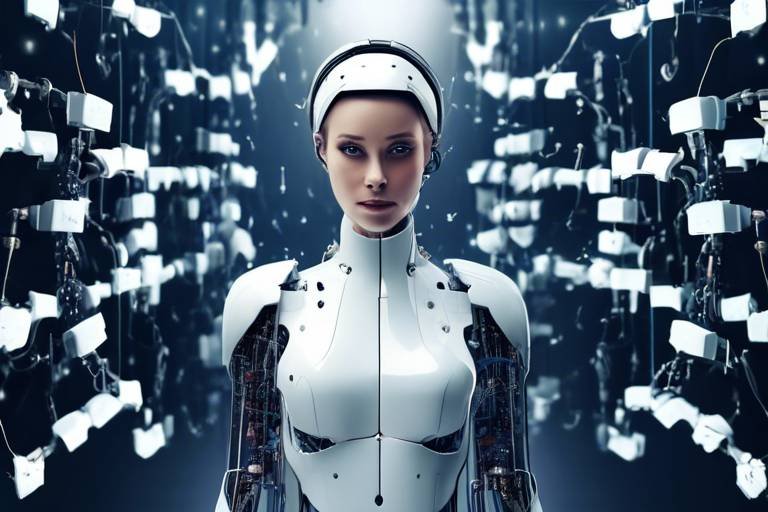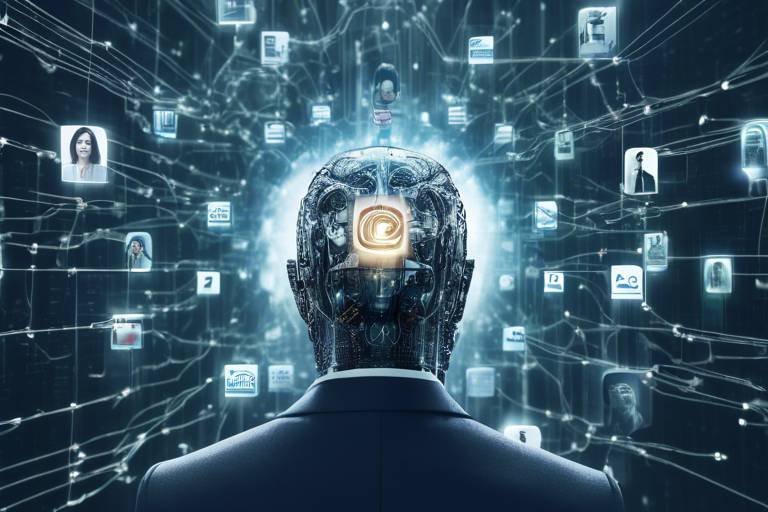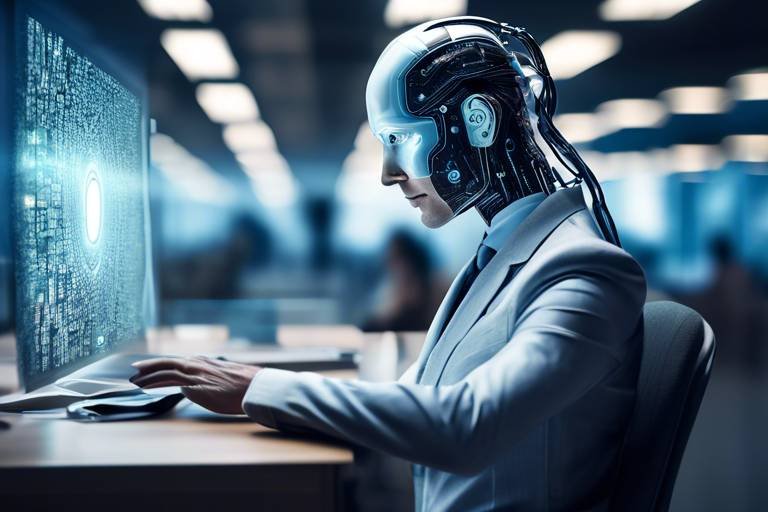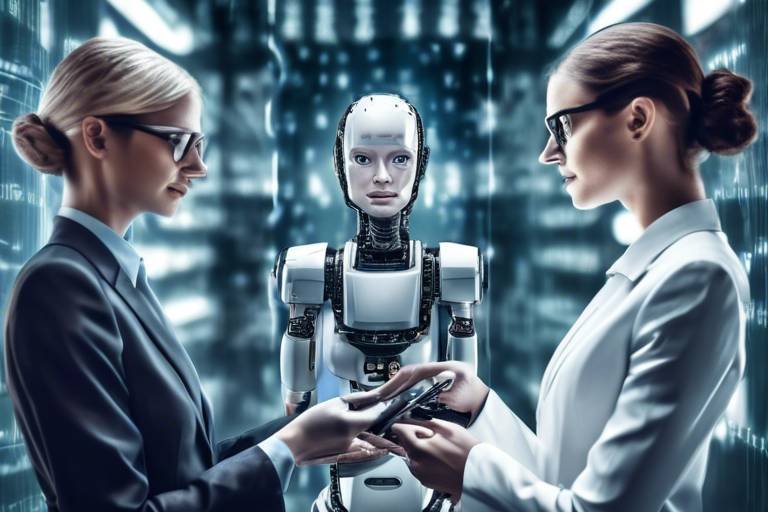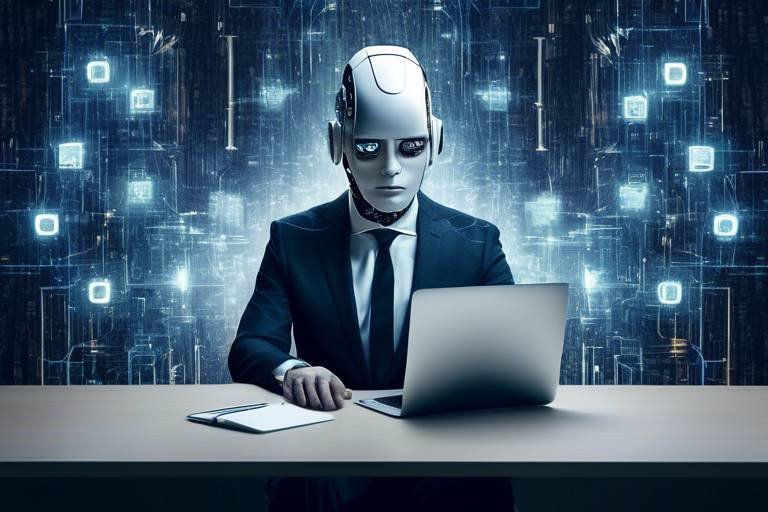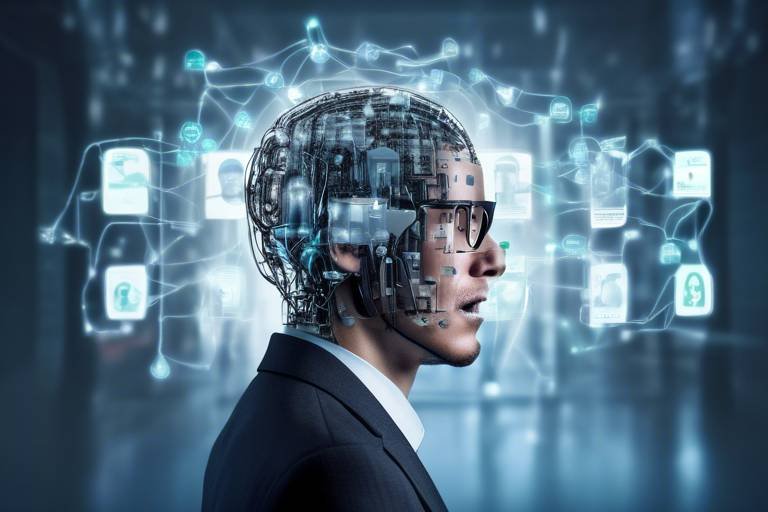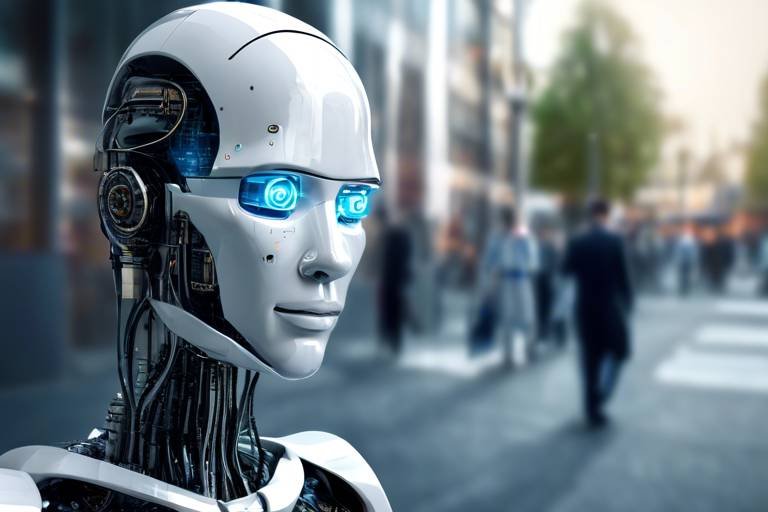Building an AI-Resilient Future Workforce: A Practical Guide
In today's rapidly evolving technological landscape, the integration of artificial intelligence (AI) into various industries is not just a trend; it's a transformative force that reshapes how we work. The question is, how do we prepare our workforce to thrive alongside these advancements? This article serves as a practical guide, exploring strategies that organizations can implement to develop a workforce that is not only resilient but also empowered to excel in an AI-enhanced environment. It's about more than just keeping up with technology; it's about fostering a culture of adaptability, continuous learning, and collaboration that harnesses the full potential of both human talent and AI capabilities.
Understanding AI technologies is crucial for employees. Why is AI literacy essential? Imagine trying to navigate a new city without a map or GPS. That's what it feels like for workers who lack a fundamental understanding of AI. By equipping employees with knowledge about how AI works and its applications, organizations empower them to adapt and excel in an AI-enhanced workplace. Not only does this knowledge foster confidence, but it also encourages innovation, as employees can leverage AI tools to improve their workflows and decision-making processes.
As AI evolves, so do the skills needed in the workforce. It's like a game of chess; the pieces may be the same, but the strategies must adapt to the changing landscape. Critical skills that will be in demand include technical proficiencies such as data analysis, programming, and machine learning, alongside soft skills like creativity, emotional intelligence, and critical thinking. Individuals can acquire these skills through various means, including online courses, workshops, and hands-on projects. The key is to remain proactive and continuously seek opportunities for growth.
Both technical and soft skills are vital for a balanced workforce. Think of it as a two-sided coin; you can't have one without the other. While technical skills enable employees to work effectively with AI tools, soft skills ensure they can communicate, collaborate, and adapt in a dynamic environment. For instance, a data analyst might need to interpret complex data sets, but without the ability to convey findings to a non-technical audience, their insights could go unrecognized. Thus, organizations should focus on developing both skill sets to create a well-rounded workforce.
Technical skills such as data analysis and programming are increasingly important in an AI-driven world. Organizations can provide training to enhance technical proficiency among employees through various methods, including:
- Workshops and boot camps focused on specific technical skills.
- Online courses that employees can take at their own pace.
- Mentorship programs pairing less experienced employees with seasoned professionals.
By investing in these training opportunities, organizations not only enhance their employees' skill sets but also demonstrate a commitment to their professional development.
Soft skills like communication, adaptability, and teamwork are essential in an AI-driven environment. In fact, as machines take over more routine tasks, the human touch becomes increasingly valuable. Organizations can foster these skills through team-building exercises, role-playing scenarios, and open feedback sessions. Encouraging a culture of collaboration and emotional intelligence will not only improve workplace dynamics but also prepare employees to work effectively alongside AI technologies.
Organizations must invest in reskilling and upskilling programs to keep pace with technological advancements. Successful initiatives can include:
- Regular training sessions tailored to emerging technologies.
- Partnerships with educational institutions for specialized courses.
- Internal knowledge-sharing platforms where employees can learn from each other.
These initiatives not only prepare the workforce for future challenges but also foster loyalty and engagement among employees who feel valued and supported in their career growth.
A culture that promotes ongoing education is crucial for adapting to AI changes. Organizations should encourage a mindset where learning is seen as a lifelong journey rather than a one-time event. This can be achieved by offering diverse learning opportunities, such as workshops, seminars, and access to online learning platforms. By creating an environment where employees feel safe to experiment and learn from their mistakes, organizations can cultivate a workforce that is not only adaptable but also innovative.
Technology can significantly enhance training programs. With the rise of e-learning platforms, organizations can provide employees with access to a wealth of resources at their fingertips. Tools like virtual reality simulations and interactive online courses can make learning more engaging and effective. By integrating technology into training initiatives, organizations can ensure that employees are well-equipped to navigate the complexities of an AI-driven workplace.
Evaluating the effectiveness of training programs is essential. Organizations should implement methods for measuring learning outcomes, such as surveys, assessments, and performance metrics. By analyzing these results, companies can identify areas for improvement and ensure that employees are gaining valuable skills for the future. This not only enhances the quality of training but also demonstrates a commitment to continuous improvement.
The future workforce will rely on collaboration between humans and AI. This partnership can lead to increased productivity and innovation, but it requires a clear understanding of AI's role in the workplace. Employees must comprehend how AI can assist them in their daily tasks, whether it's through automating repetitive processes or providing data-driven insights. By embracing AI as a tool rather than a threat, organizations can create a harmonious work environment where human creativity and AI efficiency coexist.
Employees must comprehend how AI can assist them. For instance, AI can analyze vast amounts of data, allowing employees to focus on strategic decision-making. By understanding AI's capabilities, workers can leverage these tools to enhance their performance and drive innovation within their teams. This not only boosts morale but also encourages a culture of collaboration where humans and machines work together towards common goals.
AI tools can foster collaboration among teams. Organizations can implement AI solutions that facilitate communication and project management, allowing teams to work more efficiently. For example, AI-driven platforms can help track project progress, assign tasks, and analyze team performance. By streamlining these processes, organizations can create a more cohesive work environment where teamwork thrives, and employees feel empowered to contribute their best work.
Q: What is AI literacy, and why is it important?
A: AI literacy refers to the understanding of AI technologies and their applications. It's important because it enables employees to adapt to changes and leverage AI tools effectively in their work.
Q: How can organizations promote continuous learning?
A: Organizations can promote continuous learning by offering diverse training opportunities, encouraging a culture of experimentation, and providing access to online learning platforms.
Q: What are the key skills needed for the future workforce?
A: Key skills include technical proficiencies like data analysis and programming, as well as soft skills such as communication, adaptability, and teamwork.
Q: How can companies measure the effectiveness of training programs?
A: Companies can measure effectiveness through surveys, assessments, and performance metrics to identify areas for improvement.

The Importance of AI Literacy
In today's rapidly evolving technological landscape, AI literacy has become a vital skill for employees across all sectors. But what exactly does it mean to be AI literate? At its core, AI literacy refers to the ability to understand, engage with, and leverage artificial intelligence technologies in a meaningful way. As AI systems increasingly permeate our workplaces, the ability to navigate these tools effectively is not just a bonus—it's a necessity. Imagine trying to drive a car without knowing how to operate its controls; similarly, working without a grasp of AI can leave employees feeling lost and underprepared.
Why is AI literacy so crucial? For starters, it empowers employees to take charge of their roles in an AI-enhanced environment. When workers understand how AI can assist them, they can harness its capabilities to boost productivity and streamline workflows. This understanding can lead to greater job satisfaction and a sense of agency in a world that is often perceived as being dominated by machines. Moreover, AI literacy fosters a culture of innovation, enabling employees to contribute creative ideas on how AI can be integrated into existing processes.
To put it simply, AI literacy is not just about knowing how to use AI tools; it’s about understanding the underlying principles that govern them. This includes knowledge about data privacy, ethical considerations, and the potential biases that can arise from AI algorithms. As organizations increasingly rely on AI for decision-making, having a workforce that is well-versed in these aspects is essential to mitigate risks and ensure responsible use of technology.
Organizations can take proactive steps to enhance AI literacy among their employees. Here are some effective strategies:
- Training Programs: Offering workshops and courses focused on AI fundamentals can equip employees with the necessary knowledge.
- Collaborative Projects: Encouraging teams to work on AI-related projects can foster hands-on experience and deeper understanding.
- Resource Accessibility: Providing access to AI literature, online courses, and expert talks can help employees learn at their own pace.
In conclusion, embracing AI literacy is about preparing for the future. As we stand on the brink of an AI-driven era, organizations that prioritize this literacy will not only empower their employees but also position themselves for success in a competitive landscape. A workforce that understands AI is a workforce that can thrive alongside it, turning potential challenges into opportunities for growth and innovation.

Identifying Key Skills for the Future
As we stand on the brink of a technological revolution, it’s vital to recognize that the skills needed in the workforce are evolving at a rapid pace. The rise of artificial intelligence (AI) is not just a trend; it’s a transformative force that is reshaping industries and redefining job roles. To remain competitive in an AI-enhanced landscape, individuals must identify and cultivate the key skills that will be in demand. But what exactly are these skills, and how can one acquire them? Let’s dive into the specifics.
First and foremost, it's essential to understand that the future workforce will require a blend of both technical skills and soft skills. Technical skills encompass the ability to work with AI systems, data analysis, programming, and other technology-driven competencies. On the other hand, soft skills—such as critical thinking, creativity, and emotional intelligence—are equally important as they foster collaboration and adaptability in an increasingly complex environment.
To give you a clearer picture, here’s a table that outlines some of the most sought-after skills for the future:
| Skill Type | Key Skills | Importance |
|---|---|---|
| Technical Skills | Data Analysis, Programming, Machine Learning | Essential for managing and interpreting data, automating processes, and developing AI solutions. |
| Soft Skills | Communication, Adaptability, Problem-Solving | Critical for teamwork, navigating change, and addressing complex challenges. |
Now, let’s explore how individuals can acquire these skills. One effective approach is through continuous education. This can take many forms, including online courses, workshops, and certifications that focus on the latest technologies and methodologies. For instance, platforms like Coursera and Udacity offer specialized courses in AI and data science, enabling learners to gain technical proficiency from the comfort of their homes.
Moreover, organizations play a crucial role in this skill development journey. By investing in reskilling and upskilling initiatives, companies can help their employees stay relevant. For example, mentorship programs can pair seasoned professionals with newer employees, creating a knowledge-sharing environment that benefits everyone involved. Additionally, organizations can foster an innovative culture where employees are encouraged to experiment and learn from their failures, thus enhancing their problem-solving abilities.
In summary, as we look toward the future, identifying and cultivating key skills is not just beneficial—it’s essential. By embracing both technical and soft skills, individuals can position themselves as invaluable assets in a workforce increasingly influenced by AI. The journey may be challenging, but the rewards—greater job security, career advancement, and personal fulfillment—are well worth the effort.
- What are the most important skills for the future workforce? The most important skills include technical skills like data analysis and programming, as well as soft skills such as communication and adaptability.
- How can I acquire new skills? You can acquire new skills through online courses, workshops, and mentorship programs offered by your organization.
- Why are soft skills important in an AI-driven world? Soft skills are crucial as they enhance collaboration and problem-solving abilities, which are essential in a complex work environment influenced by AI.

Technical Skills vs. Soft Skills
In today's rapidly evolving job market, the debate over technical skills versus soft skills has become increasingly relevant. Both types of skills play a crucial role in shaping a well-rounded workforce capable of thriving in an AI-enhanced environment. Technical skills, which include abilities like programming, data analysis, and cybersecurity, are essential for navigating the complexities of modern technology. These skills are often quantifiable and can be measured through certifications, degrees, or practical experience. On the other hand, soft skills encompass interpersonal abilities such as communication, teamwork, and adaptability. These are the skills that enable individuals to connect with others, navigate workplace dynamics, and respond to change effectively.
Imagine a world where a brilliant data analyst can create intricate algorithms but struggles to convey their insights to a team. Without the ability to communicate effectively, even the most talented technical expert can fall short in a collaborative setting. Conversely, consider an employee who excels in teamwork and conflict resolution but lacks the technical know-how to utilize AI tools that could enhance productivity. This scenario illustrates the importance of a balanced skill set. Organizations need employees who not only understand the technology but can also engage with their colleagues and clients in meaningful ways.
To further illustrate this balance, let's take a look at a comparison table:
| Skill Type | Examples | Importance |
|---|---|---|
| Technical Skills | Programming, Data Analysis, Cybersecurity | Essential for executing specific tasks and utilizing technology effectively. |
| Soft Skills | Communication, Teamwork, Adaptability | Crucial for collaboration, problem-solving, and navigating workplace dynamics. |
In the age of AI, the synergy between technical and soft skills is more important than ever. Companies that prioritize both skill sets will find themselves better equipped to face challenges and seize opportunities. For instance, a technical team that can communicate effectively with non-technical stakeholders is far more likely to implement solutions that meet the needs of the entire organization.
Moreover, as AI continues to automate routine tasks, the demand for soft skills will only increase. Employees who can think critically, adapt to new situations, and foster relationships will stand out in a crowded job market. Therefore, organizations should not only focus on training employees in technical skills but also invest in programs that develop soft skills. By doing so, they create a workforce that is not only technically proficient but also emotionally intelligent and capable of navigating the complexities of the modern workplace.

Developing Technical Proficiency
In today's fast-paced digital landscape, is no longer just an option; it's a necessity. As organizations increasingly rely on advanced technologies, employees must equip themselves with the skills that will enable them to thrive in an AI-enhanced environment. Think of technical skills as the tools in a toolbox—without the right tools, even the most skilled craftsman cannot complete a job effectively. So, how can organizations ensure their workforce is adequately prepared? The answer lies in a comprehensive training strategy that integrates both formal and informal learning opportunities.
One effective approach is to offer workshops and hands-on training sessions. These can be tailored to meet the specific needs of different teams within the organization. For instance, a marketing team may benefit from workshops on data analytics and SEO tools, while a software development team might require advanced coding boot camps. By providing targeted training, companies can ensure that employees are not just learning but also applying their skills in real-world scenarios. Moreover, this kind of training fosters a culture of innovation, as employees feel empowered to experiment and implement new ideas.
Furthermore, organizations can leverage online platforms and e-learning modules to enhance their training programs. These digital solutions offer flexibility, allowing employees to learn at their own pace while accessing a wealth of resources. For instance, platforms like Coursera, Udemy, and LinkedIn Learning provide courses on a wide array of technical subjects, from machine learning to cybersecurity. By encouraging employees to engage with these resources, companies can promote a sense of ownership over their learning journey, making them more likely to invest time and effort into developing their skills.
Another critical aspect of developing technical proficiency is fostering a collaborative learning environment. When employees work together on projects, they can share knowledge and skills, enhancing the overall competency of the team. This collaborative spirit can be further nurtured through mentorship programs, where experienced employees guide newer team members. Such initiatives not only benefit the mentees but also reinforce the mentors' knowledge, creating a win-win situation for everyone involved.
To measure the success of these training initiatives, organizations should implement a robust evaluation framework. This can include regular assessments, feedback sessions, and performance metrics that track employee progress. By understanding what works and what doesn’t, companies can continuously refine their training programs, ensuring they remain relevant and effective in a rapidly changing technological landscape.
In summary, developing technical proficiency is a multi-faceted endeavor that requires a strategic approach. By offering targeted training, leveraging digital resources, fostering collaboration, and implementing effective evaluation methods, organizations can empower their employees to master the technical skills necessary for success in an AI-driven world. It's not just about keeping up; it's about staying ahead.
- What are the most important technical skills for the future workforce? Skills such as data analysis, programming, and cybersecurity are becoming increasingly vital as organizations adopt more advanced technologies.
- How can employees develop these skills? Employees can engage in workshops, online courses, and collaborative projects to enhance their technical proficiency.
- Why is a collaborative learning environment important? Collaboration fosters knowledge sharing and innovation, allowing employees to learn from one another and apply their skills effectively.
- How can organizations measure the effectiveness of their training programs? By implementing regular assessments, feedback sessions, and tracking performance metrics, organizations can evaluate the success of their training initiatives.

Cultivating Soft Skills
In today's fast-paced and ever-evolving workplace, the significance of soft skills cannot be overstated. While technical skills may get you through the door, it's the soft skills that truly help you climb the ladder. Think of soft skills as the glue that holds a team together; they foster communication, collaboration, and creativity. So, how can organizations cultivate these essential skills in their workforce? It's all about creating an environment that values interpersonal relations and encourages personal growth.
First and foremost, organizations should prioritize communication training. This doesn’t just mean teaching employees how to write emails or conduct meetings, but also nurturing their ability to listen actively and express empathy. For instance, interactive workshops can be a game-changer. These sessions can simulate real-life scenarios where employees practice navigating difficult conversations or resolving conflicts. By engaging in role-playing and group discussions, employees can enhance their ability to communicate effectively, which is vital in an AI-driven workplace where collaboration with machines and humans is essential.
Equally important is fostering adaptability. The pace of change brought by AI means that employees must be prepared to pivot quickly and embrace new technologies and methodologies. Organizations can encourage adaptability by promoting a culture of experimentation. For example, allowing employees to work on innovative projects or participate in hackathons can stimulate their creative thinking and problem-solving abilities. This not only equips them with the confidence to tackle challenges but also instills a sense of ownership over their work.
Furthermore, emotional intelligence (EI) plays a crucial role in the realm of soft skills. Employees with high EI can navigate the complexities of workplace relationships and manage their emotions effectively. Organizations can cultivate EI through training programs that focus on self-awareness, self-regulation, motivation, empathy, and social skills. By integrating EI training into existing professional development programs, companies can create a more harmonious workplace where employees feel understood and valued.
Lastly, organizations should encourage a culture of feedback. Regular feedback loops allow employees to understand their strengths and areas for improvement, which is pivotal for personal development. Implementing a structured feedback system—where peers and managers provide constructive criticism—can help employees refine their soft skills over time. This approach not only enhances individual performance but also fosters a sense of community and support within the organization.
In summary, cultivating soft skills is not just a checkbox on a corporate agenda; it’s a vital investment in the future of the workforce. By focusing on communication, adaptability, emotional intelligence, and feedback, organizations can create a resilient team that thrives alongside AI technologies. The journey may be challenging, but the rewards—improved collaboration, increased innovation, and a more engaged workforce—are well worth the effort.
- What are soft skills? Soft skills are interpersonal skills that enable individuals to communicate effectively, work well in teams, and adapt to changing environments.
- Why are soft skills important in the age of AI? As AI takes over more technical tasks, soft skills become crucial for collaboration, creativity, and emotional intelligence in the workplace.
- How can organizations improve soft skills among employees? Organizations can improve soft skills through training programs, workshops, and creating a culture that encourages feedback and personal growth.
- What role does emotional intelligence play in the workplace? Emotional intelligence helps employees manage their emotions and understand others, which is essential for effective communication and teamwork.

Reskilling and Upskilling Initiatives
In today's rapidly changing job landscape, the terms reskilling and upskilling have become buzzwords that organizations can no longer ignore. As AI technologies evolve, the skills required to thrive in the workplace are also shifting. Companies that invest in these initiatives not only enhance employee competency but also foster a culture of adaptability and innovation. So, what exactly do these terms mean? Reskilling refers to training employees to take on new roles, often in response to changes in the industry or technology. On the other hand, upskilling focuses on enhancing existing skills to keep pace with advancements in the field.
Implementing effective reskilling and upskilling programs can be a game changer for businesses. For instance, organizations can adopt various strategies to ensure their workforce remains competitive. This includes providing access to online courses, workshops, and mentorship programs. By creating a structured learning path, employees can easily navigate their development journey. Additionally, companies can partner with educational institutions to offer tailored training programs that align with their specific needs.
Here are some key elements that successful reskilling and upskilling initiatives often incorporate:
- Personalized Learning: Tailoring training to fit individual employee needs ensures that everyone benefits from the program.
- Continuous Feedback: Regular check-ins and assessments help employees understand their progress and areas for improvement.
- Real-World Applications: Providing opportunities to apply new skills in actual work scenarios enhances learning retention.
Moreover, organizations can leverage technology to facilitate these initiatives. Learning Management Systems (LMS) can streamline the training process, making it easier for employees to access resources and track their progress. Additionally, incorporating AI-driven analytics can help organizations identify skill gaps and tailor programs accordingly. This proactive approach not only prepares employees for future challenges but also boosts morale and engagement as workers feel valued and invested in.
To illustrate the impact of these initiatives, consider the following table showcasing the benefits of reskilling and upskilling:
| Benefits | Description |
|---|---|
| Increased Employee Retention | Employees are more likely to stay with a company that invests in their growth. |
| Enhanced Productivity | Well-trained employees can perform tasks more efficiently and effectively. |
| Competitive Advantage | A skilled workforce can adapt to market changes faster than competitors. |
In conclusion, reskilling and upskilling initiatives are not just buzzwords; they are essential components of a forward-thinking organizational strategy. By prioritizing employee development, businesses can ensure they remain relevant in an AI-driven world while empowering their workforce to achieve new heights. The question is, is your organization ready to invest in its most valuable asset—its people?
Q: What is the difference between reskilling and upskilling?
A: Reskilling involves training employees for new roles, while upskilling enhances their existing skills to keep pace with industry changes.
Q: Why are reskilling and upskilling important?
A: They help organizations adapt to technological advancements and ensure a competitive workforce, leading to increased productivity and employee retention.
Q: How can organizations implement effective reskilling and upskilling programs?
A: By offering personalized learning paths, continuous feedback, and leveraging technology such as Learning Management Systems.

Creating a Culture of Continuous Learning
In today's fast-paced world, where technology evolves at lightning speed, creating a culture of continuous learning within an organization is not just beneficial—it's essential. Imagine walking into a workplace where every employee is excited to learn something new every day. This kind of environment fosters innovation, adaptability, and resilience, making it possible for organizations to stay ahead of the curve, especially in the age of AI. But how do we cultivate such a culture? It starts with a mindset shift, where learning is not seen as a chore but as a thrilling journey of discovery.
First and foremost, leadership plays a pivotal role in shaping this culture. When leaders prioritize learning and development, it sends a clear message to employees that growth is valued. They can lead by example, participating in training sessions and sharing their own learning experiences. This openness can encourage employees to engage more actively in their personal development. Furthermore, organizations should regularly communicate the importance of continuous learning through various channels—be it newsletters, meetings, or even casual conversations over coffee. This keeps the idea fresh in everyone’s minds and emphasizes that learning is a shared responsibility.
Additionally, organizations can leverage technology to create engaging and interactive learning experiences. Online platforms, webinars, and virtual workshops can make learning more accessible and flexible, allowing employees to learn at their own pace. Imagine a scenario where an employee can take a course on data analysis during their lunch break or watch a recorded session on leadership skills while commuting. This flexibility not only accommodates different learning styles but also integrates learning into the daily routine, making it a natural part of work life.
Another critical aspect is recognizing and rewarding learning achievements. When employees see that their efforts to learn and grow are acknowledged—whether through certificates, promotions, or even simple shout-outs in meetings—they are more likely to continue pursuing new knowledge. This recognition can be formal, like an annual awards ceremony, or informal, such as a “learning wall” where employees can post their achievements and share what they’ve learned with their peers. Such initiatives not only motivate individuals but also inspire others to embark on their own learning journeys.
To further enhance this culture, organizations can encourage peer-to-peer learning. This can be done through mentorship programs, where experienced employees guide newcomers, or through collaborative projects that require team members to share their knowledge and skills. By breaking down silos and promoting open communication, organizations can create a dynamic learning environment where everyone contributes to each other's growth.
In conclusion, fostering a culture of continuous learning is a multi-faceted endeavor that requires commitment from both leadership and employees. By promoting a growth mindset, leveraging technology, recognizing achievements, and encouraging collaboration, organizations can create an atmosphere where learning thrives. This not only prepares the workforce for the challenges posed by AI but also empowers individuals to take charge of their own professional development, making them more adaptable and innovative in the long run.
- Why is continuous learning important in the workplace? Continuous learning helps employees stay updated with industry trends, enhances their skills, and boosts overall productivity.
- How can organizations encourage continuous learning? Organizations can encourage continuous learning by providing access to training resources, fostering a supportive environment, and recognizing employee achievements.
- What role does technology play in continuous learning? Technology provides flexible learning options, such as online courses and webinars, making it easier for employees to learn at their own pace.
- Can continuous learning improve employee retention? Yes, when employees feel they are growing and developing, they are more likely to stay with the organization.

Leveraging Technology for Training
In today's fast-paced world, leveraging technology for training is not just an option; it's a necessity. Imagine a world where employees can access tailored learning experiences at their fingertips, anytime and anywhere. This is the promise of modern training technologies. By integrating advanced tools and platforms, organizations can create dynamic learning environments that cater to the diverse needs of their workforce. The key is to utilize technology not merely as a supplement, but as a fundamental part of the training strategy.
One of the most effective ways to enhance training is through the use of learning management systems (LMS). These platforms allow organizations to deliver, track, and manage training programs efficiently. With features like interactive modules, quizzes, and progress tracking, LMS can transform traditional training into engaging experiences. Employees can learn at their own pace, revisit challenging topics, and even collaborate with peers in virtual settings. This flexibility is essential in accommodating different learning styles and schedules.
Moreover, technologies such as virtual reality (VR) and augmented reality (AR) are revolutionizing the training landscape. These immersive experiences enable employees to practice skills in realistic environments without the risks associated with real-world applications. For instance, a technician can troubleshoot machinery in a simulated environment, honing their skills before facing actual equipment. This kind of hands-on experience is invaluable and can significantly improve confidence and competence.
Another crucial aspect of leveraging technology for training is the integration of artificial intelligence (AI). AI can personalize learning paths based on individual performance and preferences, ensuring that each employee receives the most relevant training. For example, if an employee struggles with data analysis, the AI system can recommend additional resources and modules specifically targeting that skill. This level of customization not only enhances learning outcomes but also keeps employees engaged and motivated.
To further illustrate the impact of technology on training, consider the following table that outlines various technological tools and their benefits:
| Technology | Benefits |
|---|---|
| Learning Management Systems (LMS) | Centralized training management, progress tracking, and accessibility. |
| Virtual Reality (VR) | Immersive learning experiences, safe practice environments, enhanced retention. |
| Augmented Reality (AR) | Real-time information overlay, interactive learning, practical skill application. |
| Artificial Intelligence (AI) | Personalized learning paths, adaptive content delivery, performance analytics. |
In addition, organizations should encourage a culture of continuous feedback and improvement. By utilizing technology to gather feedback through surveys and assessments, companies can identify areas for enhancement and adjust their training programs accordingly. This iterative process ensures that the training remains relevant and effective in meeting the evolving needs of the workforce.
Ultimately, leveraging technology for training is about creating an ecosystem that fosters learning and development. By embracing innovative tools and methodologies, organizations can not only prepare their workforce for the challenges of the future but also cultivate a culture of lifelong learning that keeps employees engaged and empowered.
- What are some examples of learning management systems?
Popular LMS options include Moodle, TalentLMS, and Blackboard, each offering unique features to facilitate training. - How can virtual reality enhance training?
VR provides immersive experiences that simulate real-world scenarios, allowing employees to practice skills safely and effectively. - Is AI necessary for effective training programs?
While not essential, AI can significantly enhance training by personalizing learning experiences and providing valuable insights into employee performance.

Measuring Learning Outcomes
In today's fast-paced world, where technology is evolving at lightning speed, measuring learning outcomes has never been more crucial. Organizations must ensure that their training programs yield tangible results, enabling employees to acquire the skills necessary for thriving in an AI-enhanced workplace. But how do we effectively measure whether our training initiatives are hitting the mark? It's a bit like trying to find the right key for a complex lock; you need the right tools and techniques to make it work.
One effective approach is to establish clear, measurable objectives before the training begins. By defining what success looks like, organizations can create a roadmap that guides both trainers and participants. For instance, if a company aims to improve data analysis skills, specific metrics such as the accuracy of data interpretation or the speed of analysis can serve as benchmarks. This way, after the training, the organization can objectively assess whether those goals have been achieved.
Another essential aspect of measuring learning outcomes is the implementation of pre- and post-training assessments. These assessments help gauge the knowledge and skills employees possess before they undergo training and compare them to their performance afterward. This method not only highlights areas of improvement but also showcases the effectiveness of the training program itself. Imagine it as a before-and-after snapshot; it vividly illustrates the transformation that has taken place.
Moreover, organizations can leverage technology to track learning outcomes. Learning Management Systems (LMS) provide valuable insights into employee engagement and progress. These platforms often come equipped with analytics tools that can monitor participation rates, completion times, and even quiz scores. By analyzing this data, companies can identify trends, such as which training modules are most effective or which employees may need additional support. It's like having a GPS for your training initiatives—guiding you to your destination with precision.
Feedback is another pivotal element in measuring learning outcomes. Gathering insights from participants can provide a wealth of information regarding the training's relevance and applicability. Surveys and interviews can be employed to capture employee experiences, allowing organizations to refine their training programs continually. This feedback loop not only enhances the quality of training but also fosters a culture of continuous improvement. Think of it as a conversation; the more you listen, the better you understand how to adapt and grow.
Lastly, organizations should consider the long-term impact of training on employee performance and organizational goals. This can be achieved through performance reviews and productivity metrics, which help assess whether the skills learned during training translate into improved job performance. By aligning training outcomes with business objectives, companies can ensure that their investment in employee development pays off in the long run.
In summary, measuring learning outcomes is a multifaceted process that requires a combination of clear objectives, assessments, technology, feedback, and performance metrics. By adopting these strategies, organizations can not only enhance the effectiveness of their training programs but also empower their workforce to excel in an ever-evolving landscape dominated by AI.
- What are learning outcomes? Learning outcomes are specific statements that describe what learners will be able to do after completing a training program.
- Why is it important to measure learning outcomes? Measuring learning outcomes helps organizations assess the effectiveness of their training programs and ensures employees acquire the necessary skills.
- How can technology aid in measuring learning outcomes? Technology, such as Learning Management Systems, provides analytics that track employee progress, engagement, and performance.
- What role does feedback play in measuring learning outcomes? Feedback from participants helps organizations refine their training programs and ensures they meet the needs of the workforce.

Collaboration Between Humans and AI
The future workforce is not just about humans or machines; it’s about the **synergy** between the two. As artificial intelligence (AI) continues to evolve, its role in the workplace is becoming increasingly significant. Employees must understand how AI can assist them in their daily tasks, enhancing their productivity and creativity. Imagine AI as a powerful tool in your toolbox — it doesn’t replace the craftsman; it enhances the craftsman’s ability to create and innovate. By leveraging AI, workers can focus on higher-level tasks that require critical thinking and emotional intelligence, leaving repetitive and mundane tasks to machines.
To truly maximize the benefits of AI, organizations need to foster an environment where collaboration between humans and AI is not just encouraged but celebrated. This means providing training that helps employees understand AI’s capabilities and limitations. For instance, employees should be aware of how AI can analyze data sets faster than any human, but they must also learn to interpret those analyses and make strategic decisions based on them. This collaborative mindset will enable teams to harness AI tools effectively, leading to improved outcomes and greater innovation.
Moreover, it's essential to recognize that effective collaboration between humans and AI can lead to significant improvements in productivity. AI can handle data-heavy tasks such as data entry, customer service inquiries, and even complex data analysis. This allows employees to redirect their focus toward more strategic initiatives, such as developing new products, enhancing customer relationships, and driving business growth. For example, a marketing team can use AI to analyze customer behavior patterns, which can then inform their campaign strategies, resulting in a more targeted approach that resonates with their audience.
To facilitate this partnership, organizations should consider implementing AI solutions that are user-friendly and accessible. Here are a few ways organizations can encourage teamwork with AI tools:
- Training Sessions: Regular workshops that teach employees how to use AI tools effectively.
- Feedback Loops: Creating channels for employees to share their experiences and suggestions regarding AI tools, fostering a culture of continuous improvement.
- Cross-Functional Teams: Forming teams that include both tech-savvy employees and those from non-technical backgrounds to promote diverse perspectives on AI integration.
As we look ahead, the collaboration between humans and AI is poised to redefine the workplace landscape. Organizations that embrace this partnership will not only enhance productivity but will also cultivate a workforce that is adaptable, innovative, and ready to tackle the challenges of tomorrow. The key lies in understanding that AI is not a competitor; it is a collaborator. By fostering a culture that embraces this collaboration, businesses can ensure they remain at the forefront of their industries.
1. How can AI improve teamwork in the workplace?
AI can streamline communication, automate repetitive tasks, and provide insights that help teams make informed decisions, allowing them to focus on creative and strategic work.
2. What skills do employees need to work effectively with AI?
Employees should develop a strong understanding of AI technologies, as well as soft skills such as communication, adaptability, and critical thinking to effectively collaborate with AI tools.
3. Are there specific AI tools that can enhance collaboration?
Yes, tools like project management software with AI capabilities, chatbots for customer service, and data analytics platforms can significantly enhance collaboration among teams.
4. How can organizations encourage a culture of collaboration with AI?
By providing training, fostering open communication about AI tools, and creating cross-functional teams, organizations can encourage a collaborative culture that integrates AI seamlessly into workflows.

Understanding AI's Role in the Workplace
In today’s fast-paced work environment, the integration of Artificial Intelligence (AI) is not just a trend; it's a transformative force reshaping how we approach our daily tasks. Imagine having a colleague who never sleeps, works tirelessly, and can analyze vast amounts of data in seconds. That’s the power of AI! Understanding its role in the workplace is crucial for employees to harness its potential effectively.
AI is designed to enhance human capabilities rather than replace them. Think of AI as a powerful tool that can take over repetitive tasks, allowing employees to focus on more creative and strategic aspects of their jobs. For instance, AI can automate data entry, manage schedules, and even assist in customer service through chatbots. By offloading these mundane tasks, employees can dedicate their time to innovation and problem-solving, which are essential for business growth.
Moreover, AI can provide valuable insights through data analysis, helping organizations make informed decisions. With predictive analytics, businesses can foresee market trends and customer behaviors, tailoring their strategies accordingly. This not only boosts efficiency but also enhances customer satisfaction, as companies can respond proactively to their clients' needs.
However, it’s essential to recognize that the successful integration of AI requires a shift in mindset. Employees must be willing to adapt and embrace this technology. A common concern is the fear of job displacement, but the reality is that AI creates new opportunities for roles that require human judgment, creativity, and emotional intelligence. To thrive in this AI-driven landscape, employees should focus on developing skills that complement AI capabilities.
To facilitate this understanding, organizations can implement training programs that educate employees on how to work alongside AI tools. This could include workshops on utilizing AI software, understanding data analytics, and exploring how AI can streamline workflows. By fostering a culture of collaboration between humans and AI, businesses can create a more innovative and productive environment.
In summary, understanding AI's role in the workplace is about recognizing it as a partner rather than a competitor. By leveraging AI, employees can enhance their productivity, creativity, and job satisfaction, ultimately contributing to a more dynamic and successful organization.
- What is the main benefit of AI in the workplace? AI helps automate repetitive tasks, allowing employees to focus on more strategic and creative work.
- Will AI replace human jobs? While some tasks may be automated, AI is more likely to create new roles that require human skills such as creativity and emotional intelligence.
- How can employees prepare for an AI-driven workplace? Employees can enhance their skills through training programs focused on AI tools and data analytics.
- What types of training should organizations provide? Organizations should offer workshops on AI software, data analysis, and collaborative strategies to maximize AI's benefits.

Encouraging Teamwork with AI Tools
In today's fast-paced work environment, the integration of AI tools has become a game-changer for fostering teamwork. Imagine a bustling office where employees are not just working side by side, but are also seamlessly connected through advanced technologies that enhance collaboration. AI tools can facilitate communication, streamline project management, and even provide insights that help teams make informed decisions. The beauty of these tools lies in their ability to act as a bridge, connecting diverse talents and perspectives to achieve common goals.
One of the most significant advantages of AI in teamwork is its capacity to analyze vast amounts of data quickly and accurately. For instance, AI-powered platforms can track project progress, identify bottlenecks, and suggest optimal solutions—all in real-time. This means that team members can focus more on creativity and strategy instead of getting bogged down by mundane tasks. Imagine a scenario where an AI tool not only reminds you of deadlines but also analyzes team performance and suggests the best time for a brainstorming session based on when everyone is most productive!
Moreover, AI tools can enhance communication among team members, especially in remote work settings. With features like instant messaging, video conferencing, and collaborative document editing, teams can work together as if they were in the same room. These tools often come equipped with AI-driven suggestions that can help improve communication. For instance, AI can analyze past conversations to recommend the best ways to approach a topic, making discussions more productive and focused.
To truly harness the power of AI for teamwork, organizations should consider implementing a few key strategies:
- Training and Support: It’s essential to provide employees with the necessary training to use AI tools effectively. This not only boosts their confidence but also ensures that everyone is on the same page.
- Encouraging Feedback: Creating a culture where team members can share their experiences with AI tools helps organizations refine their approach and improve tool effectiveness.
- Integrating AI with Existing Systems: Ensuring that AI tools work seamlessly with the tools already in use can enhance user experience and minimize disruption.
In conclusion, embracing AI tools in the workplace can significantly enhance teamwork by improving communication, fostering collaboration, and providing valuable insights. As organizations continue to navigate the complexities of the modern work environment, leveraging these technologies will not only boost productivity but also create a more cohesive and engaged workforce. After all, in a world where technology and human creativity intertwine, the possibilities for innovation are endless!
Q1: How can AI tools improve team communication?
A1: AI tools enhance team communication by providing real-time messaging, video conferencing, and collaborative document editing features, allowing team members to connect and share ideas effortlessly.
Q2: What are some examples of AI tools that can be used for teamwork?
A2: Some popular AI tools for teamwork include Slack for messaging, Trello for project management, and Google Workspace for collaborative document editing.
Q3: Do I need special training to use AI tools effectively?
A3: While many AI tools are user-friendly, providing training can help employees maximize their potential and feel more confident in using these technologies.
Frequently Asked Questions
- What is AI literacy and why is it important?
AI literacy refers to the understanding of AI technologies and their implications in the workplace. It's crucial because it empowers employees to adapt to new tools and processes, ensuring they remain relevant and effective in an AI-enhanced environment. With AI literacy, workers can leverage technology to improve their productivity and decision-making.
- What key skills should I focus on for the future workforce?
As AI continues to evolve, both technical and soft skills will be essential. Key technical skills include data analysis, programming, and familiarity with AI tools. On the other hand, soft skills like communication, problem-solving, and adaptability are equally important. Balancing both types of skills will prepare you for a successful career in an AI-driven world.
- How can organizations support reskilling and upskilling initiatives?
Organizations can implement various programs such as workshops, online courses, and mentorship opportunities to support employee development. Investing in training resources and creating a culture that encourages continuous learning can significantly enhance workforce capabilities and ensure they are equipped for future challenges.
- What role does technology play in training and development?
Technology enhances training programs by providing innovative tools and platforms that facilitate learning. Online courses, interactive simulations, and AI-driven training modules can make learning more engaging and accessible for employees. Leveraging technology helps organizations create personalized learning experiences that cater to individual needs.
- How can we measure the effectiveness of training programs?
Measuring learning outcomes can be done through various methods, such as assessments, feedback surveys, and performance metrics. By evaluating the knowledge gained and its application in real-world scenarios, organizations can determine the effectiveness of their training programs and make necessary adjustments to improve future initiatives.
- What does collaboration between humans and AI look like?
Collaboration between humans and AI involves leveraging AI tools to enhance human capabilities. This partnership can lead to increased productivity, innovation, and efficiency in the workplace. Employees can use AI to automate repetitive tasks, analyze data, and make informed decisions, allowing them to focus on more strategic and creative aspects of their jobs.
- How can organizations encourage teamwork with AI tools?
Organizations can implement AI solutions that facilitate communication and collaboration among teams. Tools that support project management, data sharing, and real-time feedback can enhance teamwork. By fostering an environment where AI is seen as an ally rather than a competitor, organizations can improve collaboration and drive collective success.


